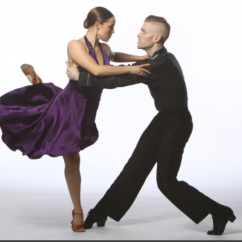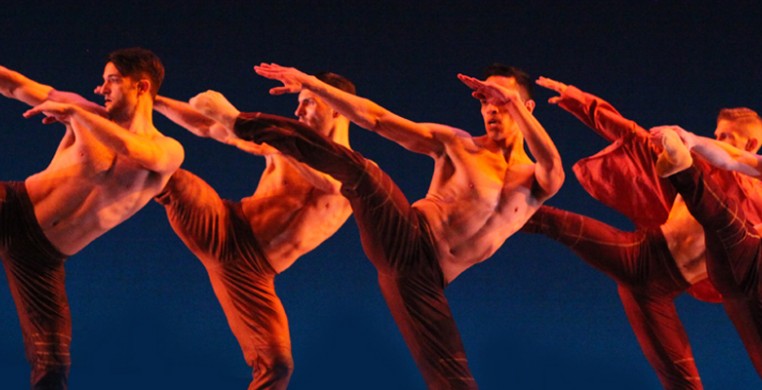It would be easy to applaud Giordano Dance Chicago’s fall season at The Harris Theater for wowing its audiences with the go-for-broke, knock ‘em dead high energy, clean-as-a-whistle technique, and joyous group spirit we have come to expect from this unique troupe. It would also be easy to expect them to simply continue to replicate what is working so well, and why not? For most companies, that’s plenty hard in itself. But that’s not the Giordano way, and never has been.
From the time its founding director, Gus Giordano, first envisioned a dance aesthetic that would elevate jazz dance to the concert dance stage, to its present incarnation as a world-class jazz-based dance company under the inspired leadership of Gus’s daughter, Nan Giordano, and executive director Michael McStraw, Gus’s pioneering spirit and insatiable appetite for artistic development continue to infuse GDC’s ethos.
The company etched a stunning profile of supreme polish in Friday night’s opening moments of longtime company favorite, “Sabroso” (2011), Del Dominguez and Laura Flores’ Latin ballroom-inspired rhapsody for ten dancers. The five women, seductively chic in Branimira Ivanova’s nightclub dresses in jewel tones of green, purple, and blue, glowed in relief against Kevin Dreyer’s red-lit cyclorama. The men were all pelvis and sinewy shoulder rolls in all-black tuxedo pants and shirts, cutting a sharp edge on Latin accents. Ballroom-sexy body language gave just enough suggestiveness to keep the mood steamy but fun throughout “Sabroso,” which means “delicious,” and indeed it was! The choreographic structure, inventive and ever-engaging with alternating moods of sass, gusto, and sultry passion, melted into the background, letting the sheer life of its super-charged inhabitants, vibrant and immediate, take center stage.
“Sabroso” was the perfect choice to open GDC’s 53rd season, giving testimony to the company’s evolving maturity, both in the depth and range of expressiveness in individual dancers--Maeghan McHale and Martin Ortiz Tapia were especially marvelous in the rich coupling of their slow duet--as well as the augmenting artistic sophistication of the entire troupe. Extensions weren’t just high kicks, but breathed beyond, in nuanced phrasing and attenuated reach. Back arches drank deeply, turns spun with radiating command that transcended precision, and deep pliés found the time and space to luxuriate in the timbre of a soulful trombone. The big bang of “Wow!” may be enough for popular consumption, but it is gratifying to see GDC striving for, and reaching, aesthetic quality that takes the idiom to a new plane, actively pursuing its stated goal of redefining the parameters of jazz dance.  Ashley Downs and Adam Houston in "Sabroso"
Ashley Downs and Adam Houston in "Sabroso"
The evening continued with consistent fidelity to its opening, each part revealing yet another dimension of GDC’s signature “Wow!” that side-stepped the trap of overkill, with sensitive interpretation, variety in musical pairings, and diverse choreographic styles.
The world premiere of Israeli-born Ronen Koresh’s “Crossing/Lines” is a non-linear, multi-layered piece in episodes alternating large and small ensembles. Aspects of the movement echo his earlier GDC creation, “EXit4” with earthy stomping, torso undulations, and head bobbing. Primitive, ritualistic gestures and spatial formations lend a pervasive sense of tribal solidarity. While there is considerable mix of musical styles and movement dynamics, an overriding sense of supplication to a higher universal force colors the whole, with arms raised overhead in v-formation and faces lifted skyward. The almost relentless intensity of Koresh’s movement implies purpose and meaning. Compelling and always exciting to watch for its inventiveness and spatial design, the cohesive theme remains general, revolving around the necessity of community, exorcism of bad spirits, and, when all is said and done, submission to something greater than ourselves that somehow ignites our will to go on. The overall tone evokes the Middle East, in musical sounds as well as in movement, which borrows liberally from folk forms, with flat-footed stomps, flapping hands, flexed feet and knees, guttural vocal yells, walks in second position plié, and hieroglyphic arm gestures. Wild torso and arm swinging alternates with controlled flow as the piece culminates in a group dance that seems to be about about dancing and curiously ends up in a French cabaret-style mime melodrama.  Devin Buchanan and Ryan Galloway in "Crossing/Lines"
Devin Buchanan and Ryan Galloway in "Crossing/Lines"
It was refreshing to see the company breathe new life into older repertory, and notable to observe the rich dynamic variance and interpretive depth the dancers brought to virtuoso dancing that, in the past, easily survived on sheer all-out energy alone.
Ron De Jesus’s “Prey” (2003) showcased three women and four men in a wind-swept volley of female bodies flying into the arms of men. Breathtaking in its high-stakes partnering, the work uses a combination of western and Tibetan liturgical chant to suggest its title has double meaning as both “prey” and “pray,” with couples, both same gender and mixed gender, often in oppositional movement, and women manipulated and carted offstage upside-down in full spits. Ryan O’Gara’s dramatic lighting on the draped fabric backdrop complimented the dancers’ breezy, air-born movement and swift exchanges across the stage, which culminated in the sudden release of all restraints as the draped fabric collapsed to the floor.
Christopher Huggins’ “Pyrokinesis” (2007) shifted energy to a softer quality, relying on the breath in lyrical sequences of falling and suspending, from air-born to the floor in seemingly instantaneous transitions, the effort behind which is magically concealed. The piece gave the dancers a chance to do what each does best. Zachary Heller dazzled with multiple turns à la seconde, Maeghan McHale’s mind-boggling chaîné turns were faster than a speeding bullet, and Devin Buchanan’s leaps defied gravity. Joshua Blake Carter’s phenomenal barrel turns, and Natasha Overturff and Martin Ortiz Tapia’s subtle rhythmic accents at break-neck speed all showed off the depth of technical strength in the company. Throughout all the pyrotechnics, in a literal breath of fresh air, “Pyrokinesis” never punched its impact, but continued to breathe. Lucky for us, so does Giordano Dance Chicago.

